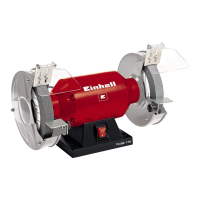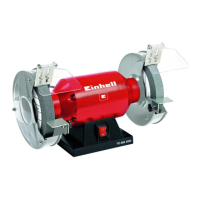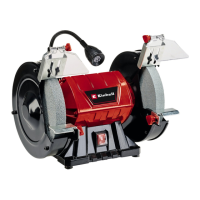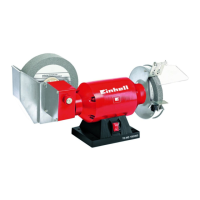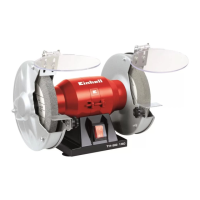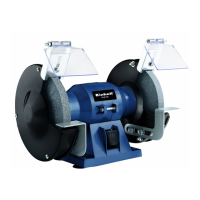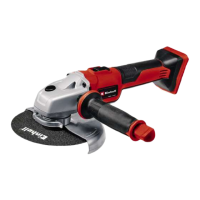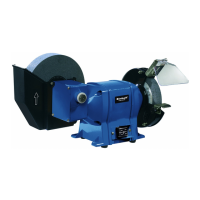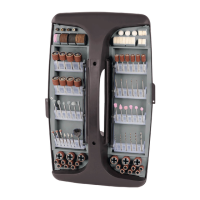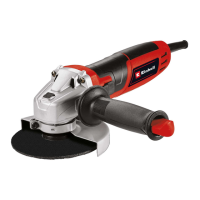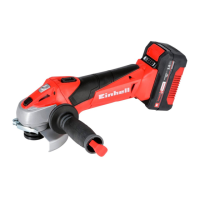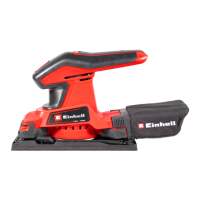GB
- 22 -
scribed in 5.2 in order to push up the spark
deflector (3). Position the spark deflector (3)
at the maximum height.
•
Note! Use a rag, cloth or similar to secure the
grinding/sanding wheel (5, 6) against rotation.
•
Undo the nut (B) by applying a 19 mm wrench
and holding the grinding/sanding wheel (5, 6)
securely with a rag, cloth or similar.
•
Note! 19 mm wrench not supplied.
•
Note! Turn the nut (B) in the direction of rotati-
on of the grinding/sanding wheel (5, 6).
•
Remove the nut (B), the flange (C) and the
old grinding/sanding wheel .
•
Before you fit the new grinding/sanding
wheel, carefully clean all the parts that rotate
during operation.
•
Fit the new grinding/sanding wheel (5, 6),
flange (C) and nut (B) in reverse order and
tighten.
•
Note! Tighten the nut (B) moderately - the
screw connection is designed to promote the
clamping of the grinding/sanding wheel du-
ring operation.
•
Then refit the cover (4) using the 3 screws
(A).
•
Adjust the spark deflector (3) as described
in 5.2.
•
Warning! Check that the safety devices are in
good working condition before you work with
the equipment again.
•
Warning! Always use the grinding/sanding
machine with a grinding/sanding wheel fitted
on each side. This will reduce the risk of tou-
ching a rotating spindle.
6. Operation
6.1 ON/OFF switch (1)
To switch on the equipment set the On/Off switch
(1) to position I.
Move the ON/OFF switch (1) to position 0 to
switch off the equipment.
After switching on the equipment wait for the
equipment to reach its maximum speed of rotati-
on before commencing with the sanding/grinding
work.
6.2 Grinding/sanding
•
We recommend that you use the fine-grained
grinding/sanding wheel (6) for fine grinding/
sanding work and the coarse-grained grin-
ding/sanding wheel (5) for coarse grinding/
sanding work.
•
Place the workpiece onto the workpiece
support (7) and slowly guide the workpiece
towards the grinding wheel (5, 6) at the desi-
red angle to the point where workpiece and
grinding wheel make contact.
•
Move the workspiece slightly back and forth
to produce an optimal grinding result. This
way the grinding wheel (5, 6) is evenly worn.
Allow the workpiece cool every now and then.
Caution!
If the grinding/sanding wheel becomes jammed
during operation, remove the workpiece and wait
until the tool reaches its top speed again. If ne-
cessary, use less force when moving the workpie-
ce against the grinding/sanding wheel.
7. Replacing the power cable
Danger!
If the power cable for this equipment is damaged,
it must be replaced by the manufacturer or its
after-sales service or similarly trained personnel
to avoid danger.
8. Cleaning, maintenance and
ordering of spare parts
Danger!
Always pull out the mains power plug before star-
ting any cleaning work.
8.1 Cleaning
•
Keep all safety devices, air vents and the
motor housing free of dirt and dust as far as
possible. Wipe the equipment with a clean
cloth or blow it with compressed air at low
pressure.
•
We recommend that you clean the device
immediately each time you have finished
using it.
•
Clean the equipment regularly with a moist
cloth and some soft soap. Do not use
cleaning agents or solvents; these could at-
tack the plastic parts of the equipment. Ensu-
re that no water can seep into the device. The
ingress of water into an electric tool increases
the risk of an electric shock.
Anl_TC-BG_150_SPK9.indb 22Anl_TC-BG_150_SPK9.indb 22 16.06.2020 15:18:2816.06.2020 15:18:28
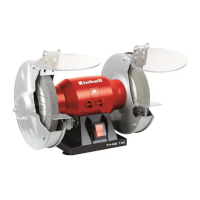
